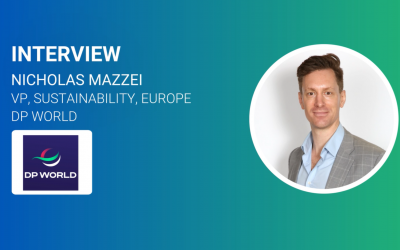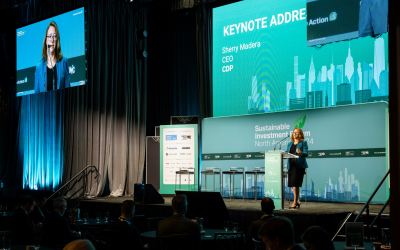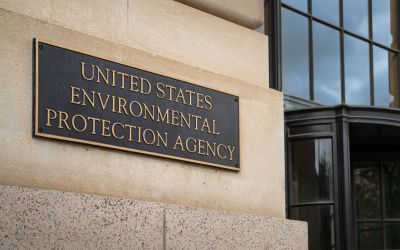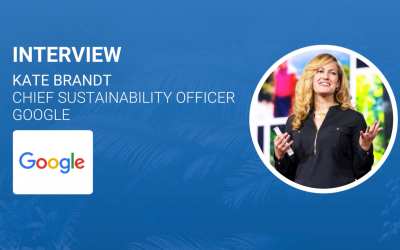Thomas Saueressig, SAP SE on how software can help us realign with the goals of the Paris Agreement
After the Sustainable Innovation Forum 2020, we caught up with Thomas Saueressig, member of the Executive Board of SAP SE for SAP Product Engineering, to discuss in depth if software can realign us with the goals of the Paris Agreement.

After the Sustainable Innovation Forum 2020, we caught up with Thomas Saueressig, member of the Executive Board of SAP SE for SAP Product Engineering, to discuss in depth if software can realign us with the goals of the Paris Agreement.
1. Can software realign us with the goals of the Paris Agreement?
Climate change like the current pandemic will have a lasting impact on prosperity and economic growth.
Research shows that 3°C of warming by 2100 has the potential to reduce the level of global GDP in 2100 by 21%. The vulnerable places and poor people will be mostly impacted and need all our support to address the root causes and mitigate the impact of climate change. However, the world is not making progress at nearly the pace and scale needed to meet our collective goals. 2100 sounds far away, but our children will certainly experience it. At the same time, climate action would have the potential to create 24 million new jobs globally by 2030.
To keep the temperature rise well below 2°C for this century and to pursue a limit of 1.5 degrees Celsius specified in the Paris Agreement, we would have to reduce greenhouse gas emissions by 7.6% annually. But even this year, which is characterized by reduction, renunciation, and even lock-downs, a decrease in greenhouse gas emissions of only about 6% is expected. This illustrates that structural change is needed as well as new innovative approaches. To our opinion, businesses play a key role in reaching carbon emission targets.
Companies are facing a changing climate as the pressure is increasing from all sides:
Customers: Both B2B and B2C customers are increasingly educated and demanding of products and services that minimize negative environmental impact.
Investors and Insurers: Financial investors and insurers are increasingly integrating climate risk in their investment strategy and policies, hampering access to capital and coverage for companies with high climate risk exposure.
Government regulation is increasing in many jurisdictions and impact business operations in their carbon emissions, waste management, product design and manufacturing, and producer responsibility.
Employees are increasingly vocal and demanding about their employers’ environmental policies and actions. It is becoming more challenging to recruit top talent without a demonstrable positive environmental vision and track record.
Luckily, awareness is rapidly changing, and I believe we are on the edge of a fundamental reshaping of finance and business decision making.
Software can support and accelerate this new type of business decisionmaking and with that, make a very decisive contribution to reach net zero emission.
The right tools and technology allow the agility to shift all kinds of resources to where they are most needed, while managing them efficiently.
According to the SMARTer2030 study from Accenture, new digital technologies are able to reduce global carbon emissions by 20% by 2030. For example, software enables us to optimize distribution, transports, or inventories by predicting demand. It also accelerates the Circular Economy, which means that what is waste for the one company, this might be a starting point for another company. Additionally, software can support sustainable supplier management within intelligent networks.
2. What is the role of decision making? How has it changed and how can business make better, data-driven decisions for climate impact?
Until now, companies have primarily focused on the growth of their top and bottom lines, and thus mainly considered financial indicators such as TCO or ROI for their business decisions. However, businesses should define success differently than purely financial. There are strong interdependencies between planet, profit, and people, so why just focus on one and ignore the others? This is certainly more than just a strategic decision. It is a cultural change that requires a mindset shift and must be exemplified by top management in corporates.
At SAP, we follow such an approach with our own SAP Integrated Report[KC1] . Next to our financial results, we also disclose our environmental performance, including emissions, e-waste results, and energy consumption, as well as our social performance. This includes for example the ratio of women in management, employee engagement, employee retention, business health culture, and leadership trust.
SAP’s Integrated Report provides a more complete picture of the total value that has been created. It is also a better foundation to take decisions and steer our business while taking economic, social, and environmental impact into consideration. We were recently recognized, for instance, as the software industry leader in the Dow Jones Sustainability Indices for the 14th year in a row.
Modern cost accounting captures costs on a granular level, enabling sophisticated cost analysis and optimization methods. If a company's system allows the capturing of the required information at the transaction level, we see no fundamental difference between methods to minimize costs and methods to minimize CO2 emissions. Sustainability metrics should be given the same importance as other information such as costs or time so that companies can take a truly holistic approach to business decisions by incorporating economic, social, and environmental impacts.
This will enable a new dimension of corporate success, and we would like companies to benchmark on a third dimension, the Green Line.
3. How can technology help businesses add “green” as the new dimension to strategic decision making?
Companies are currently still lacking the right tools to integrate sustainability holistically into their business decisions. In most cases, this only works with massive manual effort and is limited to own company boundaries. That is why we started our Climate 21 initiative. With this initiative, we are embedding sustainability metrics such as CO2 emissions natively into our analytical and transactional applications. In the first step, this will help our customers to understand and analyze the carbon footprint of their products and operations along their value chains. That way, we can start a market transformation to net zero – by understanding the CO2 footprint of a business.
CO2 emissions do not just happen; they are the result of many distributed business decisions at all levels of the enterprise. Businesses that want to minimize their CO2 footprint need the right tools to analyze the impact of production, transportation, and logistics. After all, the carbon footprint of products accumulates along value chains and across industries. We know that supply chain emissions are on average 5.5 times as high as a corporation’s direct emissions. This dynamic, transparent, and real time insights lay the foundation for ultimately minimizing CO2 emissions in day-to-day operations.
Climate 21 also enables us to minimize the carbon footprint not only of individual products and companies, but for entire supply chains. It’s software that delivers this effect in a highly interconnected world. If we imagine that SAP’s customers distribute 78% of the world's food and 82% of the world's medical devices, and that each of them limits their CO2 emissions just a little, we get an idea of what impact that could have overall.
4. Who is Climate 21 aimed at?
In the public discussion, the energy-intensive companies in the energy industry, the oil and gas sector, and the chemical industry are often in focus. However, what we should not forget is that CO2 is part of an end-to-end supply chain, and ultimately finds its way into our fridge or garage. At the end of the day, we are all responsible for climate change and therefore also responsible to make a difference for the generations to come.
5. Is software the silver bullet against climate change?
That would be nice, but unfortunately it is more complex. Since CO2 emissions do not stop at any border, climate action requires a coherent global strategy. It requires coordination and engagement of investors, companies, cities, regulators, NGOs, and every individual. Local complexities are creating new pressures to steer planning and decision making globally and with greater transparency.
The COVID-19 pandemic cannot be an excuse to slow down efforts to stop climate change. It is an opportunity to rebuild better. That is why we need a common vision of a resilient, sustainable, and fair economic recovery. We are not building something that stands-alone but something that integrates across company boundaries and across the private sector. While no single entity can stop climate change alone, taking the lead in implementing key climate actions will have a multiplier effect.
It is up to every individual to take responsibility for the future. After all, everyone is responsible for whether we still win the Race to Zero with their actions, their attitude and their habits. Everyone can contribute, whether within their role in the company or in their private life as a consumer. Every single small contribution adds up to a huge impact overall.
Neil Armstrong’s famous quote on the moon landing hits it quite well: "It's one small step for a man, one giant leap for mankind."
Didn't get a chance to join us at the Sustainable Innovation Forum 2020? Don't worry, you can watch Thomas Saueressig's session on demand and hear from all of our other industry leading experts by signing up here.






